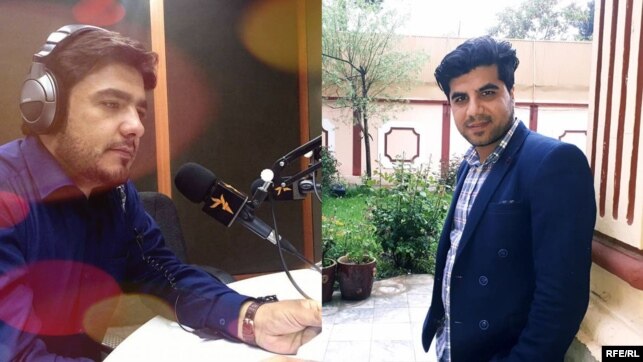RFE/RL Journalists Among At Least 25 Killed In Kabul Suicide Bombings
Two RFE/RL journalists were among at least 25 people killed in a pair of coordinated suicide bombings that rocked central Kabul near the headquarters of Afghanistan’s intelligence agency.

KABUL — Two RFE/RL journalists were among at least 25 people killed in a pair of coordinated suicide bombings that rocked central Kabul near the headquarters of Afghanistan’s intelligence agency.
A third reporter who was expected to join RFE/RL in May was also killed and the Afghan Journalists Center (AFCJ) said at least nine journalists died in the April 30 attacks, the worst toll ever among media workers in a single attack in the country.
A BBC journalist was killed in a separate attack the same day in Khost Province, south of Kabul, the British broadcaster said.
The extremist group Islamic State (IS) claimed responsibility for the blasts, in the capital, which the Afghan Free Media Support Foundation (NID) reported killed 29 people.
Police and the Health Ministry put the number of dead at 25, and police said 45 wounded victims were hospitalized — including six journalists. Kabul police spokesman Hashmat Stanekzai was quoted as saying that four police officers were killed.
Health Ministry officials said a suicide bomber on a motorcycle blew himself up in the Shash Darak area, home to NATO headquarters and several embassies and foreign offices as well as the Afghan intelligence service.
A second blast followed about 20 minutes later when a suicide bomber pretending to be a reporter blew himself up outside the headquarters of the Urban Development and Housing Ministry among the journalists covering the first explosion.
One RFE/RL journalist, Abadullah Hananzai, was killed in the second blast. Another, Sabawoon Kakar, was injured and died later in the hospital.
“This is devastating news,” said RFE/RL President Thomas Kent. “We are appalled by the loss of these courageous journalists and colleagues, and heartbroken for their families.”
Maharram Durrani,* 28, was to begin working for RFE/RL in mid-May. She was on her way to the office of Radio Free Afghanistan for training when the attack occurred.

Video and photographs from the scene showed bodies strewn about streets littered with rubble as soldiers and onlookers rush to help the wounded, sirens from a stream of ambulances wailing in the background.
“The targeting of civilians, worshipers in mosques, national and democratic processes, journalists, and freedom of expression are concrete examples of war crimes,” President Ashraf Ghani said in a statement. “This terrorist act is in conflict with Islamic values and human rights.”
Kabul police spokesman Hashmat Stanekzai as saying that four police officers were killed in the explosions.
In a statement issued via its Amaq news agency, IS claimed responsibility for the blasts and said they targeted the headquarters of what the extremist group called the “renegade” Afghan intelligence services in Kabul.
General John Nicholson, the commander of U.S. and NATO forces in Afghanistan said: “We condemn in the strongest terms possible the cowardly attacks in Kabul today by two suicide bombers that killed and injured Afghan forces and innocent Afghan citizens, including Afghan journalists.
In a separate blast on April 30 in the southern part of the country, 11 children were killed and 16 others, including five Romanian soldiers, were injured, when a bomb-filled car exploded in the southern province of Kandahar, provincial police spokesman Qasim Afghan said.
“Make no mistake, the enemies of Afghanistan cannot win. Actions like this one only strengthen our steadfast commitment to the people of Afghanistan,” Nicholson added.
Kabul police chief Dawood Amin said the area near the attacks has been sealed off and an investigation was under way.
Kakar, 30, had been a member of the video team for RFE/RL’s Radio Free Afghanistan for five years.
Hananzai, 26, was a journalist and video cameraman who had been working on an antinarcotics project for RFE/RL’s Radio Free Afghanistan called Caravan of Poison.
AFP said that Shah Marai, the French news agency’s chief photographer in Kabul, was among the journalists killed.
The AFJC said the other journalists killed were Ali Salimi and Salim Talash of MashalTV, Nawruz A. Khamoosh and Ghazi Rasuli of 1TV, and Yar Moh Tokhi of ToloNews.
BBC Afghan reporter Ahmad Shah, 29, was killed in an attack in Khost Province on the Pakistani border, BBC World Service Director Jamie Angus said on Twitter.
“An attack on the media is an attack on democracy and an effort to silence the voice of voiceless. I condemn today’s terrorist attacks and wish speedy recoveries to those wounded,” Afghan Chief Executive Officer Abdullah Abdullah said on Twitter.
The twin bombings in Kabul came eight days after a suicide blast killed 60 people and wounded at least 120 outside a voter-registration center in the capital, a blow to efforts to hold long-delayed parliamentary elections in October.
IS claimed responsibility for the April 22 attack in Dashte Barchi, a heavily Shi’ite-populated area in western Kabul, also through Amaq. The Sunni extremist group has frequently targeted Afghanistan’s Shi’ite minority, which IS calls “apostates.”
The government in Kabul is also battling Taliban militants, who were driven from power by the U.S.-led invasion 17 years ago.
Hundreds of people have died in several attacks in Kabul since the beginning of the year, despite Ghani’s offer of peace talks with the Taliban militant group “without preconditions.”
* This article has been corrected to clarify Maharram Durrani’s relationship with RFE/RL.